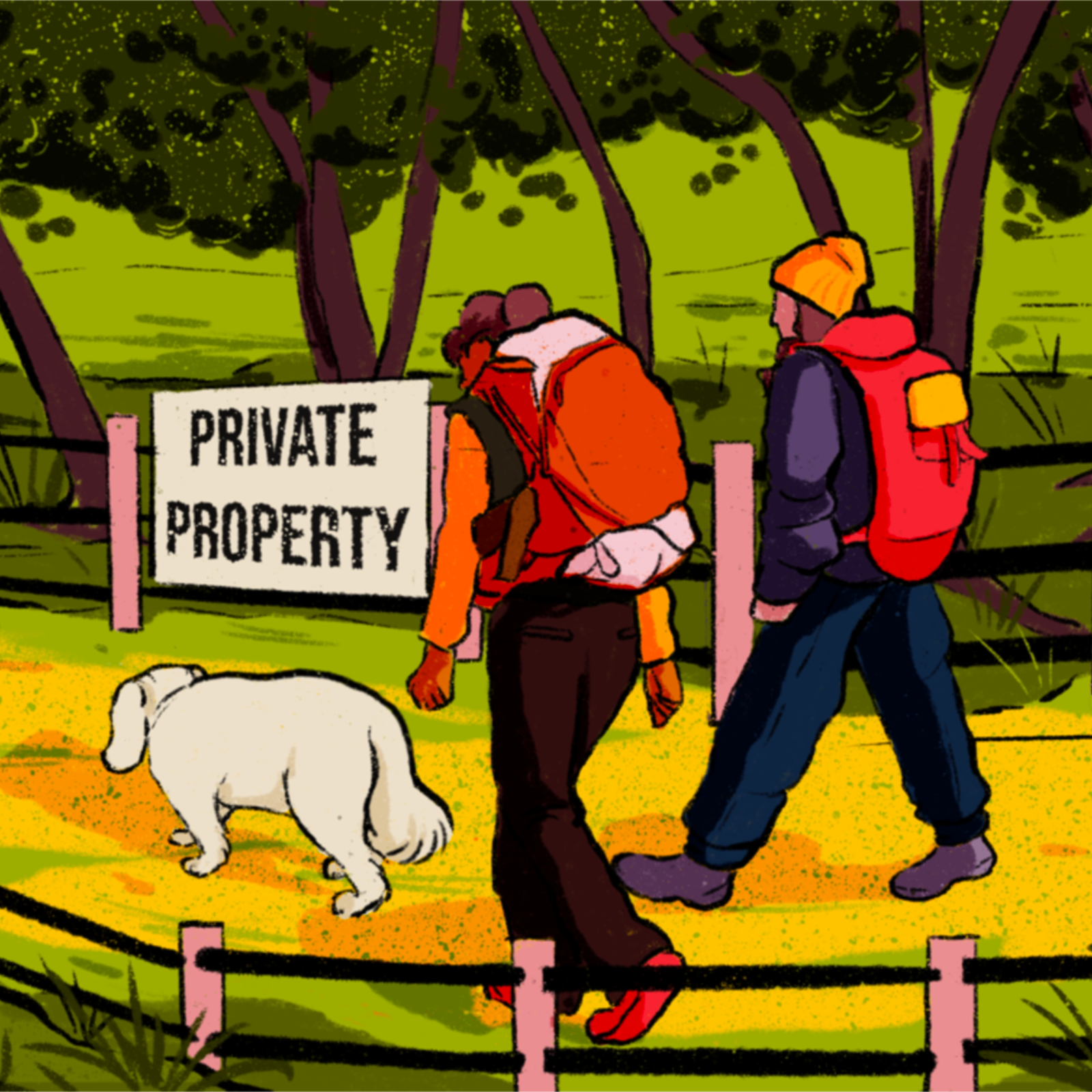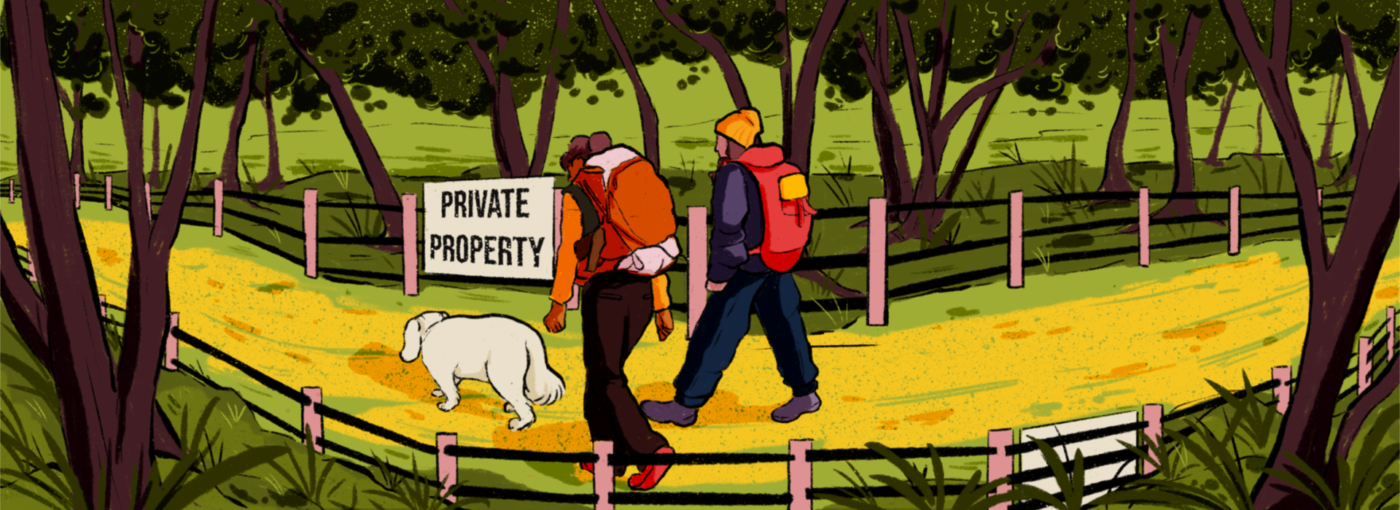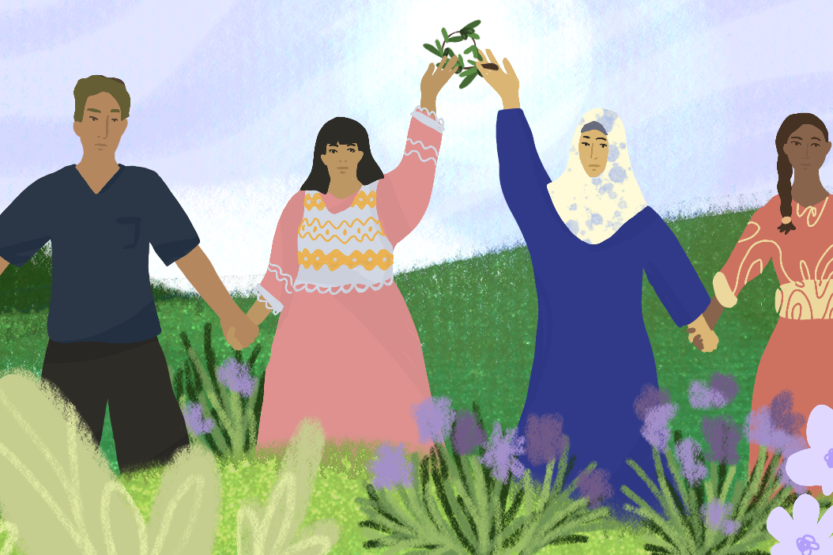“There have existed men who had the power to hold or to give exclusive possession of portions of the earth’s surface, but when and where did there exist the human being who had the right?”
Henry George, ‘Progress and Poverty’ (1879)
“As long as you respect
that this is Mother Nature’s home:
feel free to wander;
you have the Right to Roam”
Right to Roam campaign poster (2021)
Stuck over “No Trespassing” signs across England
Though we don’t acknowledge it, there’s no mistaking that our innocent stroll has just become a trespass. As we clamber over the barbed wire, our conversation flows unbroken, mimicking the wind and wild garlic’s disregard for the lightly weaponized boundary. Even so, I feel the impish flutter of doing something a bit naughty. But what makes this side of the fence so different to that?
I’ve come to Winsley, Wiltshire, to speak to professional trespasser Nick Hayes. It’s a bright spring morning; George Floyd’s murderer has just been found guilty on all counts; football fans are bringing down the proposed European Super League – the fabric of reality feels lucid, charged with possibility. We’re veering onto private farmland for reasons both practical and political: the secluded riverside perch provides not only a stunning setting but an apt one, given what we’re here to discuss.
In England, the public are forbidden from accessing 92 per cent of the country’s land and 97 per cent of its waterways. Placing just a toe into these spaces is considered trespassing, a civil offence that can quite easily be upgraded to a criminal charge. Unsurprisingly, this private acreage isn’t distributed evenly: half of England is owned by just 1 per cent of its population; a third of Britain belongs to the “aristocracy”. Take the Duke of Buccleuch, for instance. His family estate, Boughton House, is over 30 times the size of Hyde Park. Not only that, he owns a further 270,000 acres (110,000 ha) of the British Isles. That’s equivalent to around 19 Manhattan Islands, or 10 Paris cities. Bear in mind, a third of people in the UK don’t own a home at all, and one in every 200 people in England are homeless.
People have fought against England’s oppressive land system for centuries. In the spring of 1649, a group of 40 radicals began planting vegetables on St George’s Hill, near the town of Weybridge. The Diggers, as they’re now known, sought to make “the Earth a Common Treasury for All, both Rich and Poor, That every one that is born in the Land, may be fed by the Earth”. Their camp didn’t even last the summer. The local landowner, with military support, drove them out, accusing the group of illegal assembly, riot and trespass.
I decided to find out what had become of St George’s Hill. The first link Google hands me, a property website, displays a list of £15 million mansions, bordering a golf club. The second, an article, tells me that St George’s Hill is now “one of, if not THE most exclusive private residential address outside of London”. The article’s introduction proudly states, “Naturally, access is restricted.” Naturally.
Not only are we forbidden from accessing most of the country, the slivers of England that we are allowed to set foot on hardly constitute freedom. Often remote, they’re inaccessible to anyone who doesn’t own a car or can’t afford the train journey. Not only that but, in a Monty Python-esque farce, several areas marked out for public use can’t technically be reached at all – they have no public paths leading to them. As for the strips we can set foot on, we’re permitted to do little more than that …
So Nick, what rights do we have, land-wise?
You have the right to walk in a thin line on a ribbon through nature. The restriction of all the activities you’re allowed to do – swimming, raving and wild camping included – means that, unless you bloody love walking and looking at things, there’s nothing for you to do in the country. That’s the state of the nation: we treat the countryside like it’s a museum, not a place you can feel at home in. The whole inclination of the law says “this is not for you”, and that’s permeated our orthodoxy, what we consider to be the norm.
We may consider this normal today, but what did things look like a thousand years ago?
The Anglo-Saxons had a far more egalitarian concept of rights in land. It wasn’t a non-hierarchical utopia – thanes and earls owned the land, and took tithes – but people had long-established rights to use vast tracts of that land, called “commons”, to grow crops, graze animals, hunt, cut wood, forage (whatever their local resource accommodated) in return for simply giving their time and taking responsibility to collectively manage it. They believed that you never own the land, you borrow it off your grandchildren; they practiced rotational farming – there was a built-in notion of sustainability before the concept even existed, a way of keeping nature’s balance.
It was William the Conqueror who imported the idea of private property and the law of “forest” (from the Latin forīs, meaning “outside of”, as it was outside of common law), which repurposed commons as private hunting grounds for the aristocracy. That was revolutionary. A hundred years after the Battle of Hastings, a quarter of England had been forested. In the 13th century, Parliament introduced “enclosure”, the systematic privatization of land that robbed countless people of their food and homes. The Tudors invented new systems of land measurement, turning what was once a right for all into a quantifiable commodity, bought and sold by a handful of people.
They were displacing people, starving people … Was that legal?
At times, it was literally illegal. The Midland Revolt (a peasant uprising in 1607) is a great example – the protestors said they were defending England against thieves, because 350 farms had been unlawfully destroyed and almost 150,000 people made homeless. For trying to fight back against that, these starving men, women and children were cruelly, gruesomely killed.
In Tudor times, various acts made enclosure “legal” to specific areas of land because the unreformed government said so. Who was that government? The landowners! The economist Guy Standing talks about how justice itself is a commons, but justice has been privatized in a load of nuances, like the costs of court proceedings or how, when the penalty for a crime is a fine, that penalty only exists for the poor. “Justice” is bent in favour of those that have the coin – and everyone knows it.
How has enclosure and the apportioning of land affected other rights?
Enclosure not only allowed private ownership and profit to dominate the countryside, it also forced a load of self-subsistent workers off the land and into wage servitude. The commons were England’s welfare system, without the stigma. All of a sudden, you weren’t able to provide for your family by going out and doing it yourself – you had to rely on whatever your boss handed out. The fight then moved from “let us retain rights to the land” to “safeguard our rights within this new wage arena”. People weren’t campaigning anymore for the woodland to remain unenclosed, they were campaigning to not have to work 12-hour Saturdays.
This also foreshadowed colonialism; it’s like we practised seizing land and exploiting labour on our own soil before we exported it to other nations. And it was this exploitation of our own soil, our own population, that paid for this malevolence in Africa, the Caribbean and India. Today, the act of demolishing a wall would be considered violent, but they were built by violence. And they’re still violent: walls destroy links between people, they’re monuments to imbalance in society. Today’s climate and ecological crises, food insecurity, housing crisis, rising social inequality and urban environmental inequality are all linked to the current definition of private property rights, the total dominion given to owners, and the restrictions on public access to land.
Are things getting better? Or worse?
People think of enclosure as a historic phenomenon, but I’m constantly sent examples of localized enclosure: landowners blocking access to woodland so that they can chainsaw it down and create warehouse space; developers blocking up the right of way on a riverbank to put luxury flats there instead. Covid-19 has meant that a load of permissive paths have been closed by landowners, just because they can. We also now have “stopping up orders” that allow landowners to own highways.
In the last 100 years, we’ve lost half of England’s remaining public footpaths. Now, any path not registered on a new “definitive map” by 2026 will be automatically extinguished. The onus lies on regular people to, one, know about this and, two, undertake the tedious process of registering paths, in their spare time. This means reading a 316-page guide and gathering evidence like turnpike records, tithe maps, railway and canal plans, sales documents – it’s a circus of bureaucracy and legalese. They know that no one has time for that. They’re counting on it.
So, physical enclosure is still happening, but it’s also about who is welcome in the countryside. We’re told that the countryside is for straight, white, middle-class, middle-aged people to use for walking, not only by all these walls and laws, but by practically every branding or commodification of nature. But there’s nothing inherent to the countryside itself that fits that image. Nature is queer as hell; mandarin ducks change gender! In saying the
countryside isn’t for everybody, we’re systematically marginalizing people from being allowed to care for it. If they’re being told they don’t have rights to it, then of course the implication is they don’t have responsibilities for it.
Subscribe to shado's weekly newsletter
Exclusive event news, job and creative opportunities, first access to tickets and – just in case you missed them – our picks of the week, from inside shado and out.

With no power comes no responsibility?
Exactly. When people grumble, “teenagers leave so much litter” or “the travelling community leave a mess”, number one, those are stereotypes that do not apply by any means to the vast majority of those communities. There’s no evidence of having left no trace, so of course all that people can point to is the anomalous energy drink jutting out of the hawthorn hedge. Second, if teenagers are disenfranchised from the countryside and looked at as vagabonds, if the travelling community are roundly unwelcome on a systemic level, then of course that breeds a sense of nihilism or a “screw you” perspective.
It’s called the Pygmalion Effect: we act the way we are expected to, for better or worse. If you look around at the fields, the barbed wire, razor wire, fences and walls have become so normalized in our culture that we almost don’t see them. But they’re misanthropic, antisocial symbols. Our countryside has become militarized. Against what? People appreciating nature?
In 1947, a report proposing a full Right to Roam across England was shot down by landowning Members of Parliament, who saw the public as a threat to the countryside. Today, whenever we launch a campaign for greater access to nature, the arguments that come back are “the public would just trash it”. But the people saying that don’t refer to themselves as the public; there’s this non-specific Other that’s the target of distrust. This idea of the disrespectful Other ultimately becomes self-fulfilling because, when we then exclude – literally otherize – groups of people like working-class teenagers, we create the conditions for apathy and anger.
What’s the solution? How do we break the cycle?
We need to educate our children in nature; they need to be in it to care about it. At the moment, education in nature is a privilege, but those that haven’t got it are being blamed
for not knowing the Countryside Code. We’re told that the problem is human nature – that people are inherently bad or weak-willed – but it’s really the architecture of our society and systemic inequality that creates this kind of outcome. We FOI’d the government and found that, since 2004, they’d spent £2,000 a year on promoting the Countryside Code. That’s negligible.
The structure of the law also needs to be changed to encourage people to engage with nature: we need the rights to camp, swim, forage, build fires. The walk is an observation of it, you’re looking at nature, like you might look at pictures in a gallery; what we need is to be in and amongst it. How can we care about the natural world unless we can immerse ourselves in it? There are no responsibilities without rights; and there are no rights without responsibilities. It’s like walking: if you take one step with rights, to balance it, you have to take the other step with responsibilities.
It’s ironic that the argument for private property is based on protecting nature from the public, because the rights to consume, abuse and destroy are legally part of the right to private ownership.
There are undoubtedly some concerned, dedicated landowners that see their job almost primarily as stewarding nature, but it’s not the ramblers that have devastated and burnt moorland, it’s not HS2 protesters chopping down ancient woodland, and it’s not wild swimmers pouring tons of sewage into the rivers.
Property is this delusion that whatever lies on one side of a fence is entirely unconnected to the land and communities on the other side. The parcelling up or blocking off of “private entity” is a notion forced atop an ecology that doesn’t work like that. Nature’s “boundaries” – hedges, rivers, glades – are ecotones, places of transaction and interaction. You can’t just bung a fence through a space and pretend that that makes two different things. The problems that follow are things like flooding and soil depletion, as well as the simple fact that a wall will stop animal migration. When landowners are burning fossil fuels and peat bogs, destroying habitats and spraying pesticides, the consequences don’t stay neatly within their property lines. We don’t get a say in how the land is used, yet we’re all affected by it.
We’ve been lulled by the story that land is better off in the hands of private owners. The poster essay for this idea, Garrett Hardin’s “Tragedy of the Commons”, an unregulated commons, in which individuals would take more than their fair share – essentially, neo-liberalism and unregulated market. This omits the absolute key to common’s philosophy: there is no commons without collective, reciprocal, sustainable management. So, it’s just an extremely pernicious misrepresentation.
If everyone has a vested interest in the land, then everyone will want to be part of how it’s managed. Yesterday, I met a mountain biker, and we had a big old chat because they’re allowed permissive access to these woods. I was like, “So how does it work?” Basically, they regulate themselves. There’s a community of bikers who’ll not just pick up other people’s litter – because they see it as their space, which they have rights to, or belong to – but they’ll also police themselves and create their own rules for sustainability, like not making loads of ramps.
Wild swimmers in Ilkley, West Yorkshire, recently ran a campaign to show that hundreds of locals use the River Wharfe as a resource for their mental and physical well-being, so it was granted bathing water status. For it to be clean enough for humans, it will be safe for beavers, otters, all the flora and fauna that thrive off it. It’s a great case study of how, by engaging with the environment, humans can improve its resource.
Beyond the right to access the land, could we take this a step further to collective land management?
Scotland’s Land Reform Act in 2003 introduced the Right to Roam and community land ownership in one go. For instance, when the Duke of Buccleuch (Scotland’s largest landowner) decided to sell 5,000 acres (2,000 ha) of Langholm Moor, the community had the right to make an offer, and that offer was privileged over private individuals.
The idea of donating land to community land trusts was written into the Countryside and Rights of Way Act 2000. We FOI’d the government on how many people had done this and, when I asked about it, the person on the other end of the phone snorted, which suggests it’s negligible at best. When people have historically tried to turn their land into common land, their decisions have been overruled in court on the premise that they were mad to do so. It was seen as evidence of actual insanity.
The legislation is there, but we need a cultural shift away from the idea that you’d be betraying your aristocratic family or class by opening up to “the oiks”. You would be, in fact, doing something positive. In the same way that we want to heroize the act of picking up someone else’s litter, because it can keep our rights of access alive, we can also frame the idea of dedicating land to public access as caring for the land.
Landed gentry will often say it’s a full-time, stressful job looking after the land. First, could public access and engagement actually help them out? Second, are they even enjoying it? I doubt the Duke of So-and-So is reclining in a Fauvian fashion or climbing trees …
If they stopped to think about it, from their perspective, they could get loads of people to come and help manage their land because they want to get involved in nature. I was kicked off the River Loddon, which rises in Basingstoke, Hampshire, recently because the Duke of Wellington owns a quarter of it. I was walking away thinking “As if the Duke of Wellington would be out on his kayak! So who’s enjoying this?” There’s over 100,000 people in Basingstoke – some of them could collectively manage the river. Collective management could extend to anything: community groups going coppicing, hedge laying, doing wildlife surveys or building bug hotels.
It’s a win-win that might even allow us to have a nice relationship with the dude who’s riverbank you swim in or woods you walk in. To be able to say “Morning” rather than “Oh shit”. Then he could say, “Well if you’re going to be here, could you keep an eye on those sheep or pull out those weeds over there.”
So, how do we get there? Can we find common ground with landowners, or do we need an uprising?
Oh, I would love an uprising. Boringly, the practical solution is to maintain property ownership, but to override the privileges that it gives people with more equitable rules. If people start having to pay land value tax rather than receiving handouts, or if you ban land banking, then why the hell would a company in Singapore buy up land in Stroud? Farm subsidies are being reviewed at the moment; it’s mainly environmentally focussed, but why can’t public access be part of that? Paying landowners to allow public access is a practical and fair way to get them on board.
In terms of finding “common ground” with landowners, this idea exists in both metaphor and reality. To actually have common ground is to have a physical place where two people can meet without one being able to control the way the other person’s day goes. We’re sat here and, at any moment, the farmer could come along and very aggressively not just end our experience of this riverbank but also inject our bloodstreams with feelings of fear and guilt. How is that a good structure for human beings to exist within? The most fulfilling chats I’ve had with people from outside my “tribe” have been in the open countryside. When you’re
in a situation and place which isn’t premised upon a hierarchy, you’re actually able to find common ground on common ground. So there has to be a structural, architectural solution to division, we have to design ways for people to meet on a par.
When the Berlin Wall came down, Germans described a Mauer im Kopf, “a wall in the head” that the physical wall had implanted psychologically. Even as late as the 2000s, Germans were still estimating places across the ghost wall as being further away than they really were, because of this internalized mental divide. Borders buttress this feeling of division or opposition: if I’m on the other side of the fence to you, we’re opposites. Whereas if you remove that fence – that glorious metaphor of common ground – our conversation and disagreement can move to different points without being limited to a tennis-like, binary interaction.
So walls really do have a psychological effect, they nest themselves in the way we think about our relationship to nature and to life. This idea of dividing nature is just denying reality. A wall is just cemented denial.
What else can people do to help reclaim our rights to engage with the land?
Andy Wightman, one of Scotland’s key land rights campaigners, told me that one reason Right to Roam was possible in Scotland was that loads of people took their right to roam anyway – they were just going walking regardless – and so landowners were interested in regulating it. That’s not the case yet in England. We need a generation of Benny Rothmans, out trespassing. If you do, just follow the Scottish Outdoor Access Code – I always do. It’s where we want to be heading: a connection with nature that foregrounds respect for the countryside’s ecologies and communities, human and non-human. This includes respecting people’s privacy.
Obviously no one wants strangers camping in their garden, but surely allowing access to vast private property isn’t home invasion?
This notion that we want to trespass on people’s back gardens is just a reactionary, mad reframing of the issue. There are hundreds of thousands of acres of open spaces behind private walls. There’s plenty of space in England for people to pitch a tent, leave no trace, enjoy the dawn chorus and disappear.
Every country that has a Right to Roam protects an area of privacy. There’s an understanding that the curtilage of a private dwelling – the extent of its home, garden and drive – are personal sanctuaries that shouldn’t be invaded. In Sweden, you can’t walk or camp within 70m (76 1⁄2 yards) of this curtilage. In Norway, it’s 150m (164 yards). In Scotland, they let you use your common sense in allowing “reasonable measures of privacy”.
For centuries, the Right to Roam has been deliberately conflated with home invasion. This is so lacking in nuance which governs trespass, doesn’t distinguish between climbing into someone’s back garden and taking a woodland stroll in a 13,000-acre (5,300-ha) estate. Of course people have a right to privacy in their home, but when an estate extends over tens of thousands of acres, we have to ask: how much land does one person need?
Throughout our conversation, I’ve been secretly hoping that the farmer who owns this field will stagger over, hurling outrage. He doesn’t, though. Instead, a heron graces the Avon, skimming the glinting surface before gliding off into the cerulean. Just another intruder, enjoying someone else’s river.
**Extract from Nature Is A Human Right: Why We’re Fighting For Green in a Grey World, edited by Ellen Miles (DK, 2022). Get a copy here.
What can you do?
- Trespass! Sign up to the Right To Roam newsletter at righttoroam.org.uk to keep up to date with actions they have planned or organise your own.
- Donate to the campaign, at righttoroam.org.uk/donate.
Read:
- Read Nick Hayes’ book The Trespassers Companion to find out more about how to tresspass effectively. See trespasserscompanion.org
- Guerrilla Gardening: Taking back the city one seed bomb at a time
 Illustration by Heedayah Lockman @heedayahlockman who says “This illustration portrays the limited access our public has to nature. The footpath is fenced as the land now belongs to private owners, and people are shown viewing nature from a distorted perspective–as if it were a museum.”
Illustration by Heedayah Lockman @heedayahlockman who says “This illustration portrays the limited access our public has to nature. The footpath is fenced as the land now belongs to private owners, and people are shown viewing nature from a distorted perspective–as if it were a museum.”















